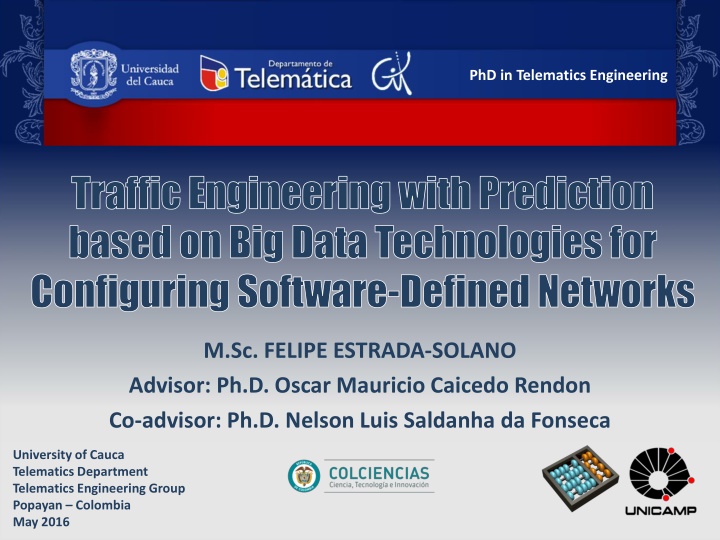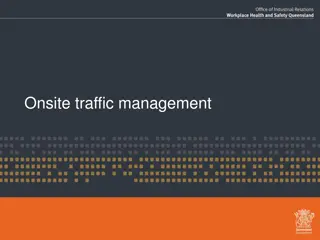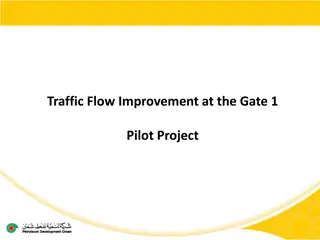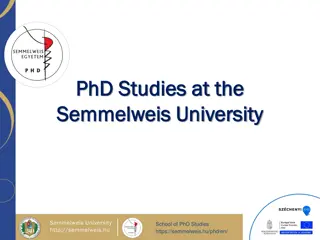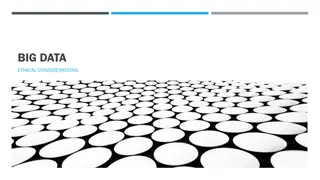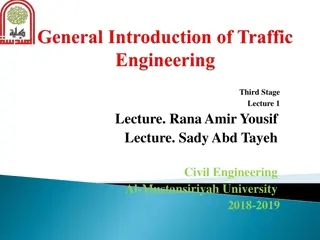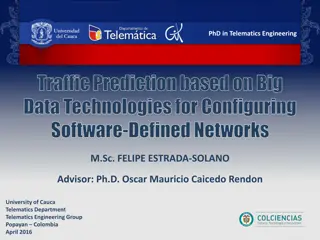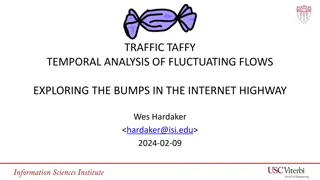PhD in Traffic Engineering with Big Data Predictions for Software-Defined Networks
This PhD thesis delves into utilizing big data technologies for predicting traffic in software-defined networks. It aims to enhance traffic engineering through advanced analysis and configuration, leveraging predictive models and network insights. Exploring the intersection of telematics and traffic management, the research contributes to the evolving landscape of network optimization and performance enhancement.
Download Presentation

Please find below an Image/Link to download the presentation.
The content on the website is provided AS IS for your information and personal use only. It may not be sold, licensed, or shared on other websites without obtaining consent from the author.If you encounter any issues during the download, it is possible that the publisher has removed the file from their server.
You are allowed to download the files provided on this website for personal or commercial use, subject to the condition that they are used lawfully. All files are the property of their respective owners.
The content on the website is provided AS IS for your information and personal use only. It may not be sold, licensed, or shared on other websites without obtaining consent from the author.
E N D
Presentation Transcript
PhD in Telematics Engineering Traffic Engineering with Prediction based on Big Data Technologies for Configuring Software-Defined Networks M.Sc. FELIPE ESTRADA-SOLANO Advisor: Ph.D. Oscar Mauricio Caicedo Rendon Co-advisor: Ph.D. Nelson Luis Saldanha da Fonseca University of Cauca Telematics Department Telematics Engineering Group Popayan Colombia May 2016
Outline Background Motivation Problem Statement Hypothesis Goals Advance 2
Background Background Traffic Prediction Software-Defined Networking (SDN) Big Data Background Motivation 3
Traffic Prediction Background Traffic Information Predict Collect Analyze Future Traffic Network Anomaly detection Admission control Capacity planning Traffic engineering Configure Knowledge of relationships between network behavior and network configuration may help to decide the best parameters according to real performance feedback Traffic engineering with prediction is a promising approach to accommodate time- varying traffic without frequent route changes e.g., congestion avoidance on the basis of the predicted traffic (Otoshi et al., 2015) (Akyildiz et al., 2014) Background Motivation 4
Software-Defined Networking Background Defines a new architecture for future networks Separates the Data and the Control planes, allowing a simpler network operation from a logically centralized software program Applications 1. Centralized global view 2. Dynamic programmability of multiple forwarding devices 3. Open interfaces 4. Flexible flow management Decision policies Open APIs Controller SDN Protocol Switch Implement more efficient and intelligent management techniques Traffic Engineering (TE) Packet Forwarding (Akyildiz et al., 2014) (Feamster et al., 2013) (Kim and Feamster, 2013) (Anwer and Feamster, 2010) (Shimonishi and Ishi, 2010) Background Motivation 5
Software-Defined Networking Background Architecture Programming languages Protocols MANAGEMENT PLANE Open System Interconnection (OSI) network management Information Organizational Communication Functional Controller Topology Discovering Host Tracking Openflow Information Model based on the Common Information Model Mashup-based and Event-driven framework (Estrada-Solano et al., 2016) (Caicedo Rendon et. al., 2016, 2013) (Wickboldt et al., 2015) (ONF, 2014) (Efremova and Andrushko, 2015) (Kiran and Kinghorn, 2015) (Kreutz et al., 2015) (Casado et al., 2014) (Rijsman and Singla, 2013) (ONF, 2012) Background Motivation 6
Big Data Background Data Management Acquisition and recording Extraction, cleaning and annotation Integration, aggregation and representation Volume Velocity Variety Zettabytes+ Terabytes Batch Streaming Structured Unstructured Data Analytics Modeling and analysis Interpretation Veracity Variable Valence Value Reliable Unreliable Constant Irregular Correlated Disconnected Trivial Significant Collect and analyze huge amounts of data to obtain significant results that allow predicting events and improving decision-making (Gandomi and Haider, 2015) (Jagadish et al., 2014) (Siewert, 2013) (Laney, 2001) Background Motivation 7
Motivation Background Applications SDN requires to cope with traffic management Time-varying traffic Different traffic types Controller Redundant resource capacity Overly large capacity Low resource utilization Costly and poor scalalability Switch Traffic management in SDN with limited resources Avoid congestion Optimize resource utilization Implement more efficient and intelligent traffic management techniques Traffic Engineering (TE) Background Motivation Problem Statement 8
Adaptive Traffic Engineering Background Adaptive TE Applications Analyze Decide Controller Traffic data Configuration Use traffic patterns to improve network behavior Switch Drawbacks Only observed traffic conditions, not future Heavy load High traffic Frequent configurations Prediction Time-varying traffic Background Motivation Problem Statement 9
Traffic Engineering with Prediction Background TE + Prediction Applications Data Store Controller Analyze Switch Configuration Predict Use predicted traffic patterns to improve network behavior and reduce adaptive changes during a control period Challenges Prediction time-scale Adaptive configurations Background Motivation Problem Statement 10
Traffic Engineering with Prediction Background Huge Applications Applications Controller Controller Data Switches Challenge Traffic Engineering with prediction in a data-intensive SDN environment BIG DATA Background Motivation Problem Statement 11
Problem Statement Background Due to the high variability of network traffic and the limited network resource capacity, performing traffic engineering for configuring SDN-based networks in a data-intensive environment remains ineffective in terms of time and traffic How to carry out an effective approach that performs traffic engineering for configuring data-intensive SDNs? Motivation Problem Statement Hypothesis 12
Hypothesis Background Carrying out traffic prediction supported by Big Data technologies working along the network core would lead to perform an effective traffic engineering for configuring SDN-based networks in a data-intensive environment Problem Statement Hypothesis Goals 13
Goals Background Main Goal Propose a mechanism based on Big Data technologies for implementing traffic engineering with prediction for configuring SDN-based networks in a data-intensive environment Specific Goals 1. Characterize the relationships between network traffic and network configuration for SDN in a data-intensive environment 2. Design a framework for traffic prediction supported by Big Data technologies for conducting traffic engineering in a data-intensive SDN 3. Evaluate the effectiveness of the framework through an use case in an emulated data-intensive SDN environment Hypothesis Goals Advance 14
Systematic Mapping Background Traffic engineering mechanisms in SDN Traffic monitoring Traffic classification Traffic steering Traffic prediction 0 20 40 60 80 100 120 Goals Advance 15
Systematic Mapping Background Traffic engineering in SDN regarding the FCAPS+P model Load-balancing Congestion avoidance Performance Fault tolerance Anomaly detection Fault Policy update Time-based Configuration Checking invariants Debugging errors Programming Denial of Service Malicious bots Security Usage capabilities Accounting 0 10 20 30 40 50 60 Goals Advance 16
Systematic Mapping Background Configuration in SDN SCOPUS + CiteSpace Traffic engineering as one of the major areas of research Associated terms Datacenter network Wide Area Network Scalability Capacity planning Goals Advance 17
Systematic Mapping Background Configuration in SDN Rexford, J. Walker, D. Foster, N. Princeton University Traffic engineering in SDN and conventional networks Programming languages for SDN Goals Advance 18
Systematic Mapping Background Network Traffic Prediction Model based on Training Data Prediction model K-NN (K Nearest Neighbors) algorithm from road traffic prediction Simulation results Sub-optimal performance Lack of historical data for extensive simulations Dataset from Lincoln Laboratory More recent from 2000 Intrusion detection dataset Not an SDN deployment Future work Rebuild model for high precision Real-time data Comparison with other prediction models (Park et al., 2015) Goals Advance 19
Systematic Mapping Background EMD-based Multi-model Prediction for Network Traffic in Software-Defined Networks Appropriate traffic matrix Reflect the traffic change trend of the future Result of network traffic prediction algorithm Algorithm EMD-MMP (Empirical Mode Decomposition Multi-Model Prediction) Short-term forecasting algorithm Decompose traffic series into different modes with different frequency by EMD Better results than similar algorithms ARMA (Auto-Regresive and Moving Average) SVR (Support Vector Regression) Dataset from Internet2 August 2008 Not an SDN deployment (Dai et al., 2014) Goals Advance 20
Systematic Mapping Background Conclusions Short-term forecasting approach No configuration of an SDN-based network SDN as a technology for collecting data No data-intensive environment Data fits in a single Controller No dataset from an SDN deployment Lincoln Laboratory intrusion detection Internet2 conventional network * Evaluate in an emulated SDN Simulations Goals Advance 21
Next Steps Background Review traffic prediction for SDN in 2016 Review traffic prediction in any other kind of network Describe two use cases for traffic engineering with prediction in a data-intensive SDN Datacenter networks Carrier networks Review Big Data for managing SDN Survey paper Goals Advance 22
PhD in Telematics Engineering Traffic Engineering with Prediction based on Big Data Technologies for Configuring Software-Defined Networks M.Sc. FELIPE ESTRADA-SOLANO Advisor: Ph.D. Oscar Mauricio Caicedo Rendon Co-advisor: Ph.D. Nelson Luis Saldanha da Fonseca University of Cauca Telematics Department Telematics Engineering Group Popayan Colombia May 2016
References Akyildiz, I. F., Lee, A., Wang, P., Luo, M. & Chou, W. (2014). A Roadmap for Traffic Engineering in SDN-OpenFlow Networks. Comput. Netw. 71, 1--30. Anwer, M. B. & Feamster, N. (2010). Building a Fast, Virtualized Data Plane with Programmable Hardware. SIGCOMM Comput. Commun. Rev. 40 (1), 75--82. Caicedo Rendon, O. M., Estrada-Solano, F. & Granville, L. Z. (2013). A Mashup-Based Approach for Virtual SDN Management. In Computer Software and Applications Conference (COMPSAC), 2013 IEEE 37th Annual (pp. 143-152). Caicedo Rendon, O. M., Estrada-Solano, F., Guimar es, V., Rockenbach Tarouco, L. M. & Granville, L. Z. (2016). Rich dynamic mashments: An approach for network management based on mashups and situation management. Computer Networks 94, 285 - 306. Casado, M., Foster, N. & Guha, A. (2014). Abstractions for Software-defined Networks. Commun. ACM 57 (10), 86--95. Dai, L., Yang, W., Gao, S., Xia, Y., Zhu, M. & Ji, Z. (2014). EMD-Based Multi-Model Prediction for Network Traffic in Software-Defined Networks. In 2014 IEEE 11th International Conference on Mobile Ad Hoc and Sensor Systems (pp. 539-544). Efremova, L. & Andrushko, D. (2015). What's in OpenDaylight?. [Online]. Available: https://www.mirantis.com/blog/whats- opendaylight/ Estrada-Solano, F., Ordonez, A., Granville, L. Z. & Caicedo Rendon, O. M. (2016). A CIM-based Information Model for Heterogeneous SDN Management . Computer Communications (Submitted to Computer Communications) Feamster, N., Rexford, J. & Zegura, E. (2013). The Road to SDN. Queue 11 (12), 20:20--20:40. Gandomi, A. & Haider, M. (2015). Beyond the hype: Big data concepts, methods, and analytics . International Journal of Information Management 35 (2), 137 - 144. Jagadish, H. V., Gehrke, J., Labrinidis, A., Papakonstantinou, Y., Patel, J. M., Ramakrishnan, R. & Shahabi, C. (2014). Big Data and Its Technical Challenges. Commun. ACM 57 (7), 86 94. 24
References Kim, H. & Feamster, N. (2013). Improving network management with software defined networking. Communications Magazine, IEEE 51 (2), 114-119. Kiran, S. & Kinghorn, G. (2015). Cisco Open Network Environment: Bring the Network Closer to Applications (White Paper C11- 728045-03). Cisco. Kreutz, D., Ramos, F. M. V., Esteves Verissimo, P., Esteve Rothenberg, C., Azodolmolky, S. & Uhlig, S. (2015). Software-Defined Networking: A Comprehensive Survey. Proceedings of the IEEE 103 (1), 14--76. Laney, D. (2001). 3-D Data Management: Controlling Data Volume, Velocity and Variety (Research Report 949). META Group. ONF (2014). SDN architecture v1.0 (Technical Reference TR-502). Open Network Foundation. ONF (2012). Software-Defined Networking: The New Norm for Networks (White Paper ). Open Network Foundation. Otoshi, T., Ohsita, Y., Murata, M., Takahashi, Y., Ishibashi, K. & Shiomoto, K. (2015). Traffic Prediction for Dynamic Traffic Engineering. Comput. Netw. 85 (C), 36--50. Park, J., Raza, S. M., Thorat, P., Kim, D. S. & Choo, H. (2015). Computational Science and Its Applications ICCSA 2015: 15th International Conference, Banff, AB, Canada, June 22-25, 2015, Proceedings, Part IV. In O. Gervasi, B. Murgante, S. Misra, L. M. Gavrilova, C. A. M. A. Rocha, C. Torre, D. Taniar & O. B. Apduhan (ed.), (pp. 117--127). Springer International Publishing. (ISBN: 978-3- 319-21410-8.) Rijsman, B. & Singla, A. (2013). Day One: Understanding OpenContrail Architecture. Juniper Networks Books. Shimonishi, H. & Ishii, S. (2010). Virtualized network infrastructure using OpenFlow. In Network Operations and Management Symposium Workshops (NOMS Wksps), 2010 IEEE/IFIP (pp. 74--79). Siewert, S. B. (2013). Big data in the cloud Data velocity, volume, variety, veracity (Technical Report ). IBM developerWorks. Wickboldt, J., De Jesus, W., Isolani, P., Both, C., Rochol, J. & Granville, L. (2015). Software-defined networking: management requirements and challenges. Communications Magazine, IEEE 53 (1), 278--285. 25
FCAPS vs FAB FCAPS Fault, Configuration, Accounting, Performance, and Security Telecommunications Management Network (TMN) Built on the requirements to manage network equipment and networks (bottom-up) Bottom-up / Network-centric approach Network core FAB Fulfillment, Assurance, and Billing Business Process Network (eTOM) Built on the need to support processes of the entire service provider (top-down) Information Technology Infrastructure Library (ITIL) presents the same approach Top-down / Customer-centric / Business-centric approach Service provider 26
